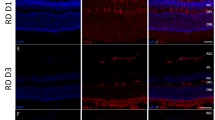Abstract
Retinal endothelial cell (REC) apoptosis occurs in response to a number of stressors, including high glucose, oxidative stress, hypoxia. Because these stressors are common factors in a number of ocular diseases, it is critical to understand the cellular mechanisms by which apoptosis occurs in REC. This review discusses the various models of REC used in ophthalmological research. The mechanisms responsible for REC apoptosis are discussed, as well as potential therapeutics currently under development to prevent REC apoptosis. The primary goal of this review is provide the reader with a background knowledge of the current state of research ongoing in REC apoptosis and potential avenues for future testing.
Similar content being viewed by others
References
Cai J, Wu L, Qi X et al (2011) PEDF regulates vascular permeability by a gamma-secretase-mediated pathway. PLoS One 6:e21164
Williams KP, Steinle JJ (2009) Maintenance of beta-adrenergic receptor signaling can reduce fas signaling in human retinal endothelial cells. Exp Eye Res 89:448–455
Busik JV, Mohr S, Grant MB (2008) Hyperglycemia-induced reactive oxygen species toxicity to endothelial cells is dependent on paracrine mediators. Diabetes 57:1952–1965
Panjala SR, Steinle JJ (2011) Insulin and beta-adrenergic receptors inhibit retinal endothelial cell apoptosis through independent pathways. Neurochem Res 36:604–612
Mohammad G, Kowluru RA (2012) Diabetic retinopathy and signaling mechanism for activation of matrix metalloproteinase-9. J Cell Physiol 227:1052–1061
Kowluru RA, Kowluru A, Kanwar M (2007) Small molecular weight G-protein, H-Ras, and retinal endothelial cell apoptosis in diabetes. Mol Cell Biochem 296:69–76
Makita J, Hosoya K, Zhang P, Kador PF (2011) Response of rat retinal capillary pericytes and endothelial cells to glucose. J Ocul Pharmacol Ther 27:7–15
Leal EC, Aveleira CA, Castilho AF et al (2009) High glucose and oxidative/nitrosative stress conditions induce apoptosis in retinal endothelial cells by a caspase-independent pathway. Exp Eye Res 88:983–991
Duffy A, Liew A, O’Sullivan J et al (2006) Distinct effects of high-glucose conditions on endothelial cells of macrovascular and microvascular origins. Endothelium 13:9–16
Stitt AW, Hughes SJ, Canning P et al (2004) Substrates modified by advanced glycation end-products cause dysfunction and death in retinal pericytes by reducing survival signals mediated by platelet-derived growth factor. Diabetologia 47:1735–1746
Kowluru RA (2005) Effect of advanced glycation end products on accelerated apoptosis of retinal capillary cells under in vitro conditions. Life Sci 76:1051–1060
McDonald DM, Coleman G, Bhatwadekar A, Gardiner TA, Stitt AW (2009) Advanced glycation of the Arg-Gly-Asp (RGD) tripeptide motif modulates retinal microvascular endothelial cell dysfunction. Mol Vis 15:1509–1520
El-Remessy AB, Rajesh M, Mukhopadhyay P et al (2011) Cannabinoid 1 receptor activation contributes to vascular inflammation and cell death in a mouse model of diabetic retinopathy and a human retinal cell line. Diabetologia 54:1567–1578
Gu X, El-Remessy AB, Brooks SE et al (2003) Hyperoxia induces retinal vascular endothelial cell apoptosis through formation of peroxynitrite. Am J Physiol Cell Physiol 285:C546–C554
Castilho AF, Aveleira CA, Leal EC et al (2012) Heme oxygenase-1 protects retinal endothelial cells against high glucose- and oxidative/nitrosative stress-induced toxicity. PLoS One 7:e42428
Boosani CS, Nalabothula N, Munugalavadla V et al (2009) FAK and p38-MAP kinase-dependent activation of apoptosis and caspase-3 in retinal endothelial cells by alpha1(IV)NC1. Invest Ophthalmol Vis Sci 50:4567–4575
Abcouwer SF, Lin CM, Wolpert EB et al (2010) Effects of ischemic preconditioning and bevacizumab on apoptosis and vascular permeability following retinal ischemia-reperfusion injury. Invest Ophthalmol Vis Sci 51:5920–5933
Kim JH, Yu YS, Kim KW, Min BH (2007) The role of clusterin in in vitro ischemia of human retinal endothelial cells. Curr Eye Res 32:693–698
Trudeau K, Molina AJ, Guo W, Roy S (2010) High glucose disrupts mitochondrial morphology in retinal endothelial cells: implications for diabetic retinopathy. Am J Pathol 177:447–455
Kowluru RA, Atasi L, Ho YS (2006) Role of mitochondrial superoxide dismutase in the development of diabetic retinopathy. Invest Ophthalmol Vis Sci 47:1594–1599
Kowluru RA, Abbas SN (2003) Diabetes-induced mitochondrial dysfunction in the retina. Invest Ophthalmol Vis Sci 44:5327–5334
Steinle JJ, Chin VC, Williams KP, Panjala SR (2008) Beta-adrenergic receptor stimulation modulates iNOS protein levels through p38 and ERK1/2 signaling in human retinal endothelial cells. Exp Eye Res 87:30–34
Jiang Y, Zhang Q, Soderland C, Steinle JJ (2012) TNFalpha and SOCS3 regulate IRS-1 to increase retinal endothelial cell apoptosis. Cell Signal 24:1086–1092
Zhang Q, Guy K, Pagadala J et al (2012) Compound 49b prevents diabetes-induced apoptosis through increased IGFBP-3 levels. Invest Ophthalmol Vis Sci 53:3004–3013
Miller AG, Tan G, Binger KJ et al (2010) Candesartan attenuates diabetic retinal vascular pathology by restoring glyoxalase-I function. Diabetes 59:3208–3215
Acknowledgments
Supported by National Eye Institute Vision Grant R01EY022045 (JJS); Juvenile Diabetes Research Foundation Grant (2-2011-597 to JJS); Oxnard Foundation (JJS); Research to Prevent Blindness Award (PI:Barrett Haik); and NEI Vision Core Grant: PHS 3P30 EY013080 (PI: Dianna Johnson).
Author information
Authors and Affiliations
Corresponding author
Rights and permissions
About this article
Cite this article
Steinle, J.J. Retinal endothelial cell apoptosis. Apoptosis 17, 1258–1260 (2012). https://doi.org/10.1007/s10495-012-0777-3
Published:
Issue Date:
DOI: https://doi.org/10.1007/s10495-012-0777-3




